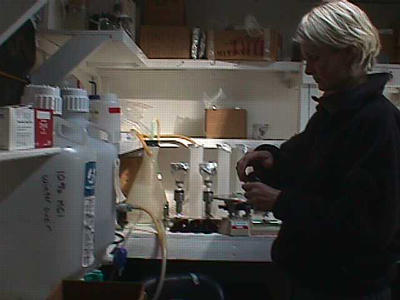
|
|
13 November, 1998
I woke up at 8:00 am to a beautiful warm, sunny day (in the 30's and
40's F). Since I had experiments to begin, I stayed back in camp today
while my team visited the Taylor, Commonwealth, and the Canada Glaciers
to collect cryoconite samples (cryoconite are areas of sediment deposit
on the glacier...you can see them very easily from the air...they look
like holes in the glacier surface because the sediment warms the ice and
melts into the ice). They took the chainsaw and collected large cubes
of ice for later sampling. John was planning to do ammonia regeneration
experiments with the ice (how bacteria change the nitrogen to nitrates),
identifying the bacteria/algae, testing bacteria/algae activity, sorting
the sediments, and doing some photosynthesis chemistry.
We had breakfast before they left. I made sandwiches for them to take,
since they would be gone all day.
After they left, I decided to collect my meltwater for my experiments
first. Then it could be melting as I did other things. I started the
preway heater in the upper lab and placed the bottles of ice on the top
shelf. As you know, heat rises, and I was hoping that the melting would
occur faster this way. As long as there is ice in the container, the
meltwater will stay pretty close to 0 degrees C.
I emptied the 2 containers of grey water in the Jamesway. This consists
of pouring them into 55-gallon barrels outside. As soon as these are
full, we roll them down the hill to await a trip back to McMurdo for
processing.
At 11:00 am the LTER team left camp to head back to McMurdo. They've
been sampling the various lakes in the Taylor Valley for about 3 weeks,
so they need a break (and a shower).
At noon, part of the Stream Team arrived (Mike Gooseff and Arne
Bomblies). Since the streams aren't running yet, they are checking the
data logging equipment and making sure everything is working before the
streams start running. They maintain 18 stream gauges in the Taylor
Valley-- they measure flow rate and stream chemistry composition. The
want to see what the water balance is in the Dry Valley system. How is
the water recycled, where is all of the water (in the streams, in the
ice, in the glacier, in the lake water), and how do the streams
contribute to the lakes? In the last 100 years, the lakes' surfaces
have risen quite a bit. Does this have anything to do with global
warming?
My question was..."Why do the glaciers just stop at certain places?
What prevents them from continuing on down the mountains?" It has to do
with a lot of factors, mainly how much evaporation or sublimation (ice
directly to vapor) is going on. Since the Dry Valleys are so windy and
dry, sublimation occurs very rapidly and continuously. Therefore, the
glacier does not seem to move very quickly down the mountain. The top
portion of the glacier will move faster than the bottom (because the
bottom is experiencing the friction of the ground), and in doing so, the
glacier will "calve" or break off from the top (as soon as it gets too
heavy on top). A little physics for you...
The Stream Team left camp to go check the stream gauges, and I decided
to clean up the Jamesway a bit. I swept out the Jamesway (it's amazing
how much dust is tracked in), made 2 chocolate silk pies, did dishes,
and washed my hair (yes, I broke down when I saw the weird grease
formations my hair was doing).
I started labeling the 90 bottles I would need for my experiment, and
realized that I had no balance with which to weigh the sediments. I was
going to run out of bottles, too, and needed to find more. I decided to
hold off my experiment until I had everything organized. That always
helps, doesn't it?
I made dinner again, since I was the only one in camp to start dinner.
I made honey mustard chicken, mushroom rice, spinach, and of course, we
had the chocolate silk pies for dessert. I caught up on my journal (my
scratch pad really...until I can get back to McMurdo to type these in an
e-mail) and checked my meltwater. The ice had just completely melted,
so I placed the containers of meltwater in the 0 degrees incubator. I
called Chris to ask for more bottles that had been rinsed in deionized
water, a balance, and more deionized water. [I don't want any ions-- or
charged parcticles-- to ruin the experiment]. I labeled more bottles,
checked my e-mail in camp for the first time, and then went to bed. My
experiment will have to wait one more day.

Me rinsing and labeling bottles in preparation for the nutrient leaching experiments. I'm standing in the upper lab of the 3 labs at Lake Bonney...pretty nice for a field camp, huh?

Nina working in the middle of the 3 labs at Lake Bonney. Many of her experiments are time-points where she has to filter every 6 hours...that can get tiring after a while!
Contact the TEA in the field at
.
If you cannot connect through your browser, copy the
TEA's e-mail address in the "To:" line of
your favorite e-mail package.
|
